30 Clever Herb Garden Ideas for Indoor or Outdoor Spaces
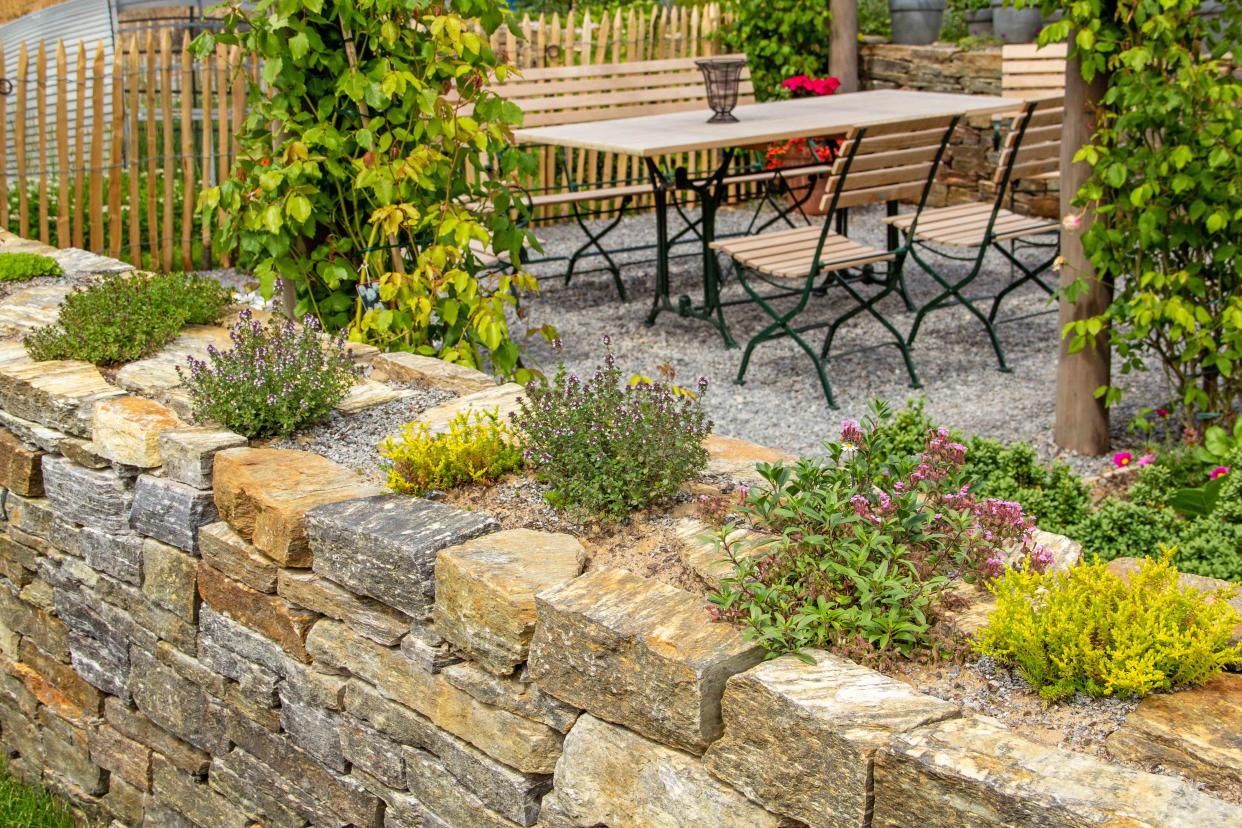
BasieB
Whether you have a windowsill to work with or you’re building an elaborate raised bed garden, anyone can grow an indoor or outdoor herb garden. You may be wondering whether you can plant basil with lavender, rosemary with cilantro, or whether mint grows well indoors. Perhaps you’re trying to figure out the best way to make use of a sunny kitchen counter in your apartment, or you need inspiration for an outdoor garden that’s as beautiful as it is functional.
We’ve rounded up 30 herb garden ideas to give you all the tips and tricks for planting your indoor or outdoor herbs, how to plan a well-designed herb garden, and what kind of containers and materials are best for your garden.
Charlotte Ekker Wiggins is an author and Master Gardener.
Rebecca Sears is the CMO & Resident Green Thumb at Ferry-Morse.
Build Raised Garden Beds

Kathryn Donohew Photography / Getty Images
There's something perfectly pastoral about raised garden beds. The minute you have them in your garden, you're donning overalls, a straw hat, and writing neat little signs to label your rows of herbs and veggies. Plus, if you have the space, these are one of the best ways to keep your herbs out of reach of critters. Add chicken wire to deter taller animal friends, like deer.
Put Pollinator Gardens in Front of Your Raised Beds

Let your flowers do double duty for you. Plant native flowers and pollinators directly in front of your raised beds to draw bees to your flowering herbs and also provide nutrients for butterfly larvae.
Create a Mobile Garden
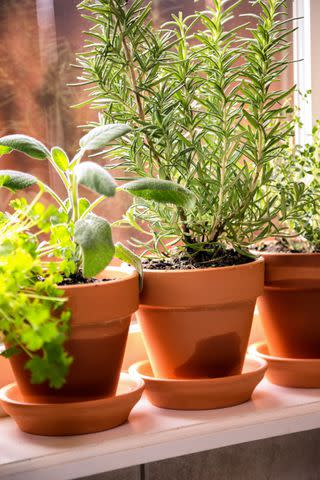
grandriver / Getty Images
Just because you started your seeds outdoors doesn't mean they have to stay there. If your plants are thriving as winter's chill threatens, bring them in.
"Since I have a spot with southwest exposure, I can successfully over winter inside rosemary, parsley, chives, oregano and chocolate mint," says Charlotte Ekker Wiggins, author and Master Gardener.
When planting herbs together, think about how they thrive. Lavender, oregano, rosemary, sage, and thyme are Mediterranean herbs that grow well in drier soil. On the other end of the spectrum, cilantro, parsley, and basil need lots of water, and do best in a damp, sunny environment.
Want to plant lavender and basil together? Not so fast. They both love sun, but, like other unfriendly herb combinations, it won't work because of their water needs.
Hang Herbs Overhead Your Dining Table
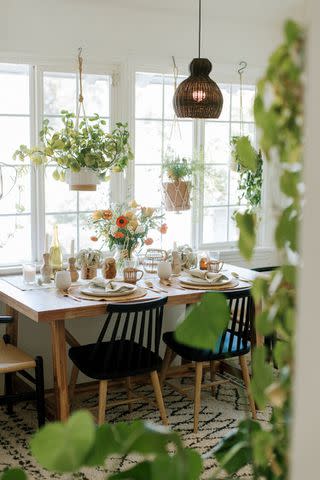
Ferns and tumbling plants are gorgeous hanging from the ceiling, particularly in a sunny window. But reserve at least one of those hanging pots for the herbs that you most often use as garnish in the kitchen.
Grow Aromatic Plants Indoors

Karl Tapales / The Spruce
Who needs candles when you have herbs?
"Spearmint is an herb I’d recommend growing indoors, as it’s highly aromatic and will release a strong minty scent in your home with just a light touch of the leaves," says Rebecca Sears, CMO & Resident Green Thumb at Ferry-Morse.
Plus, spearmint can be used in tea for an herbal touch.
Hang Baskets Away from Pet's Paws

Zen Rial / Getty Images
Whether it's toxic or just too tempting, you can use your vertical space to keep certain plants away from pets (and children, too).
Wiggins says, "I grow catnip in a hanging basket to keep it safe from inquisitive paws."
Spread Out Your Precious Plants
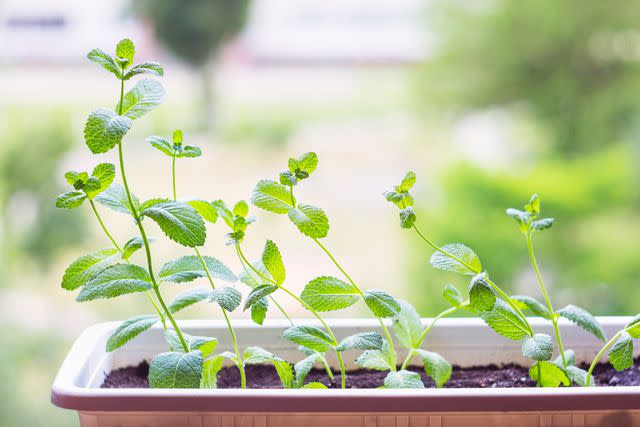
TorriPhoto / Getty Images
While a lush look may bring to mind beautiful English gardens, resist the urge to crowd your herbs.
"Although having them stacked together looks good, allow for air circulation around each herb plant. This will also help reduce any pests that may have hitchhiked from garden starts," says Wiggins.
Try Moisture-Loving Herbs in the Bathroom
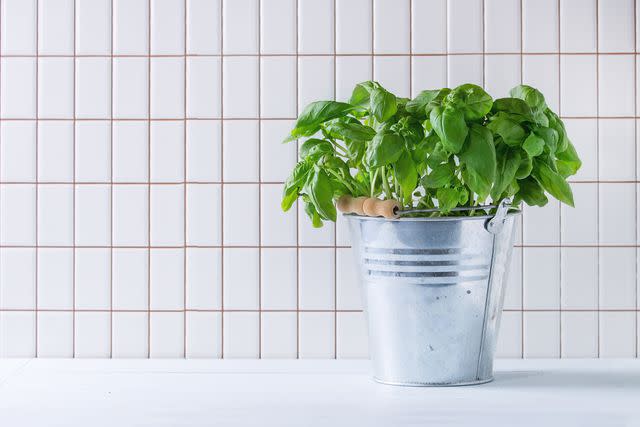
Natasha Breen / EyeEm / Getty Images
If you're in a small enough apartment that the shower is just steps from the kitchen, move your water baby herbs, like basil or cilantro, into the bathroom. They'll enjoy the high humidity and moisture, which is effectively like a greenhouse.
Keep Herbs by Your Bar Cart

Karl Tapales / Getty Images
"It's great to have mint within reach if you love making cocktails or mocktails that call for fresh mint for muddling or just to garnish," Sears suggests.
Plus, a sprig or two in a summer lemonade can't be beat.
Plant a Formal Herb Garden

clubfoto / Getty Images
Herb gardens can work with whatever space you have and, if you have space aplenty, take advantage of it. Plant a formal herb garden, which is a take on a formal decorative garden but with a practical twist. With proper planning, you can have everything from bee balm to cilantro to tarragon to chamomile, all thriving in one place.
Install a Grow Light

Susie Hedberg / Getty Images
Don't let your herb garden feel defeated just because you have less than stellar natural light in your home.
"No matter what type of herbs you grow indoors, I recommend a grow light to augment window light, as all herbs prefer full sun, which is 6+ hours of direct sun per day," says Sears.
Use Your Seedlings for a Touch of Spring

Jordan Lye / Getty Images
"Starting herb seeds indoors is a great way to get a boost of green in the off-season and to allow the seedlings to develop strong root systems before transplanting them to your outdoor garden," says Sears. Who needs to go to the Trader Joe's flower section for a touch of spring anymore?
Utilize a Grow Kit
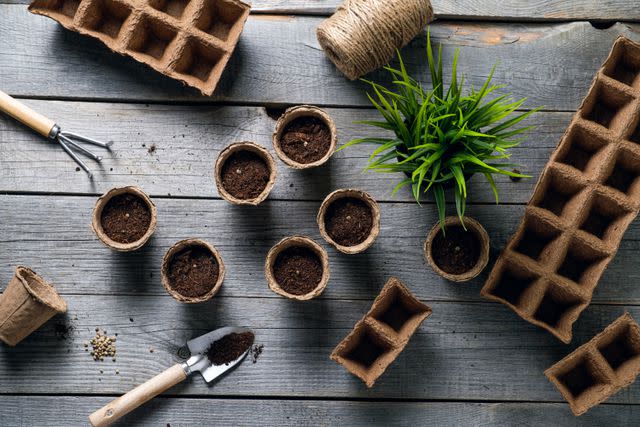
Aleksandr Zubkov / Getty Images
A grow kit gives you a ready-made home to start your plants, along with all the tips and tricks you need to success.
Sears says, "I recommend looking for a kit with as many of the fundamental seed starting supplies as possible, like seeds, seed starting pellets, and a tabletop greenhouse. You’ll also want to make sure you have a heat mat to help with seed germination and a grow light to give your plants the 'sunlight' they’re not getting from the outdoors."
Incorporate Herbs Into a Rock Garden
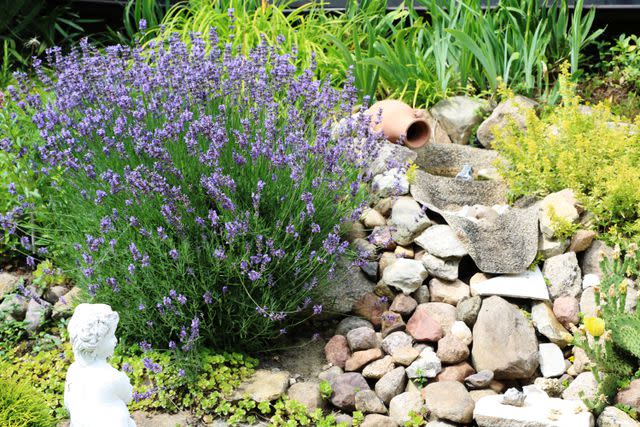
ClaraNila / Getty Images
From thyme to rosemary to marjoram to sage, there are more than a few plants that thrive in a rock garden. It's a desert-inspired look that you can accentuate with flowers, succulents, and, of course, herbs you can put to use.
Surround a Patio with Mosquito Repelling Herbs
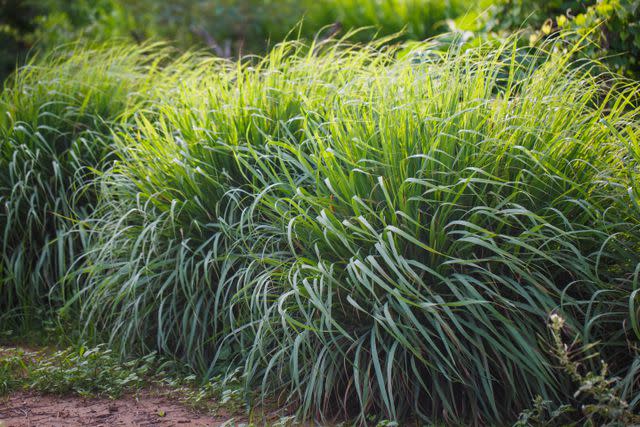
bgton / Getty Images
Herbs like lemongrass and lavender are known for their bug and mosquito-repelling qualities. While it won't work quite as well as bug spray, it does add a lovely smell and a touch of green to your patio.
Buy or DIY a Hydroponic Garden
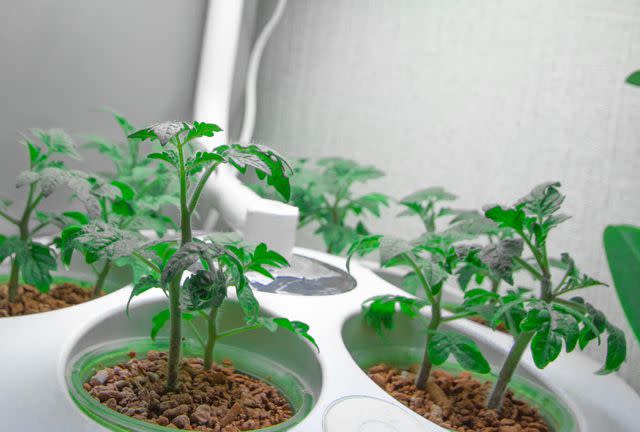
Elena Bereberdina / Getty Images
While hydroponic gardens have existed for thousands of years, they've been getting a lot of attention recently as a small space saver. Whether you buy a pre-made hydroponic garden or attempt a DIY, these clever indoor gardens keep plants flourishing without soil. Instead, they use a nutrient solution based on water and various minerals.
Sears explains, "Most herbs can be grown both indoors and outdoors, but leafy herbs like parsley, basil, and cilantro can do particularly well indoors."
She recommends starting with cilantro, since it tolerates partial sun. "More difficult to maintain indoors are woody or slow-growing Mediterranean herbs like rosemary, sage and lavender, which like strong sun," says Sears.
Fill Terracotta Planters With Herbs
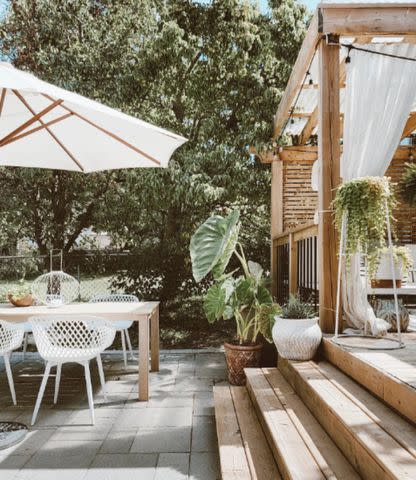
Terracotta planters don't have to be reserved for decorative plants only. Use herbs that will fill out like a bush—think rosemary or lavender—and treat them as you would any landscaping plant, only these you can harvest.
Contain Spread With Concrete Pavers

Satakorn Sukontakajonkul / EyeEm / Getty Images
Use concrete pavers to not only create a patio, but also contain the spread of fast moving herbs like mint. They'll overtake a garden quickly, but not if you keep them intentionally aligned within the grid-like design of pavers.
Make Use of a Side Garden
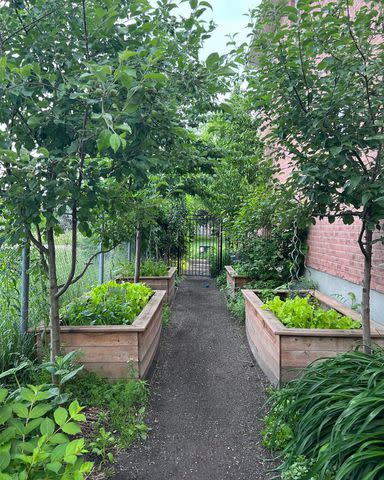
Do you have one of those side yards that turns into a no-man's land? Use it for a fragrant garden full of herbs and pollinators. You won't worry about bees if they're all the way in the side garden, and they'll keep your flowering herbs thriving.
Choose Small Decorative Pots for a Kitchen Garden

Geshas / Getty Images
If you have a sunny window, you can grow a darling kitchen garden with basil, thyme, and others. Choose small decorative pots and trim your herbs regularly, both for kitchen use, and to keep them healthy within the limited size of their containers.
Plant Woody Herbs for Year-Round Greenery

Rosmarie Wirz
For those who prefer a low maintenance approach to their herb garden, plant woody herbs like lavender and rosemary for year-round greenery. This herbs are evergreen in many climates and will continue to grow throughout the winter.
Use Self Watering Containers
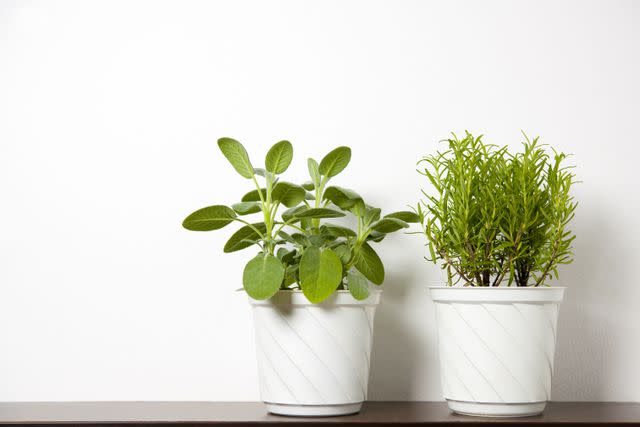
stock_colors / Getty Images
For herbs that drink up lots of water, like chives, parsley, marjoram, and mint, choose a self watering container that will keep them at an even level of moisture throughout the day, and even when you head out of town on a short trip.
Turn a Wood Pallet Into a Garden

Oksana Aksenova / Getty Images
A multi-tiered wood pallet makes for the perfect up-cycled herb garden, with its many spots for planting different herbs and plentiful flat surfaces for labeling. You can lean one against a wall or even mount it in a city garden.
Install a Trellis Garden on a Balcony
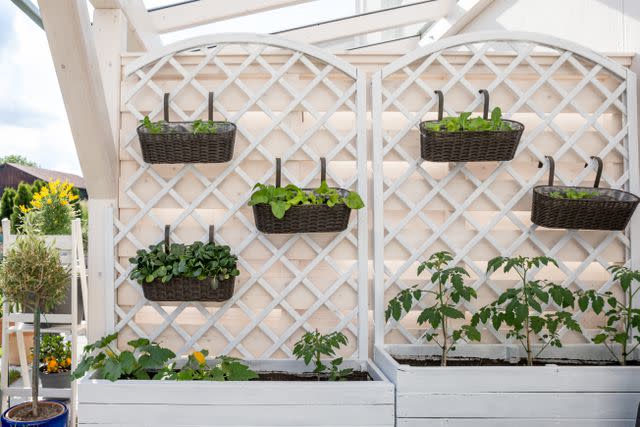
Kamadie / Getty Images
If you have a small balcony without room for pots and planters, install a vertical trellis garden on the wall. You can fit just enough room for all of your most-used herbs that do well when contained in smaller spaces: basil, dill, cilantro, parsley, and more.
Leverage a Railing
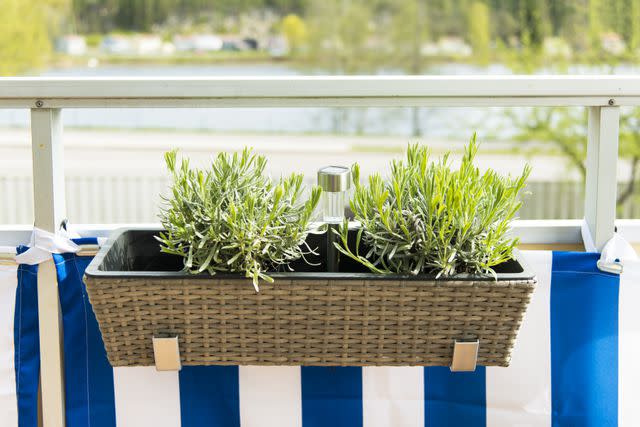
Huskystudio_se / Getty Images
A railing is often wasted space, only serving its functional (and important) purpose. But why not use it as a planter? Hang a rail planter off a sunny railing and watch your herbs thrive. Just watch out who might be below when you're watering.
Build a Vertical Garden

Westend61 / Getty Images
Even if you have a yard, the look of a vertical garden built from stacked terracotta pots or wooden crates has farmhouse appeal. For those with a DIY inclination, they are easy to build and great for herbs that either grow bushy or tumble out of their pots.
Line a Rock Wall

BasieB
You can plant herbs in a rock garden or you can line a rock wall with herbs that will cascade over its sides, both benefitting from the protection of the wall, while growing with it. Try summer savory or creeping thyme.
Grow Herbs in Upcycled Containers
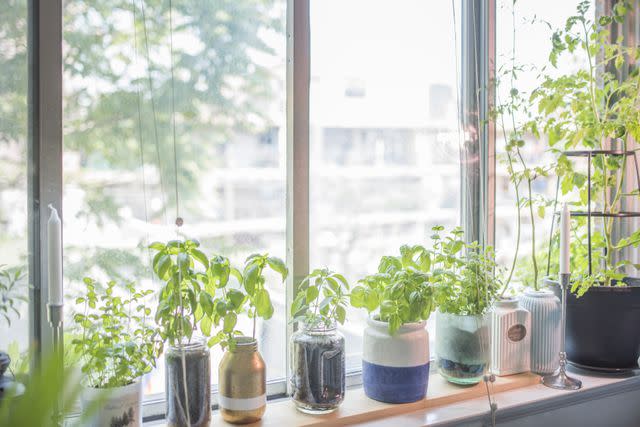
There's no need to run out and buy all new pots, planters, and specially designated containers for your herb garden. Use what you have on hand, whether that's a metal bin, old wood box, tin can, or even a cut off plastic soda bottle. Make sure there's proper drainage and your plants won't know the difference.
Grow Your Herbs in Water
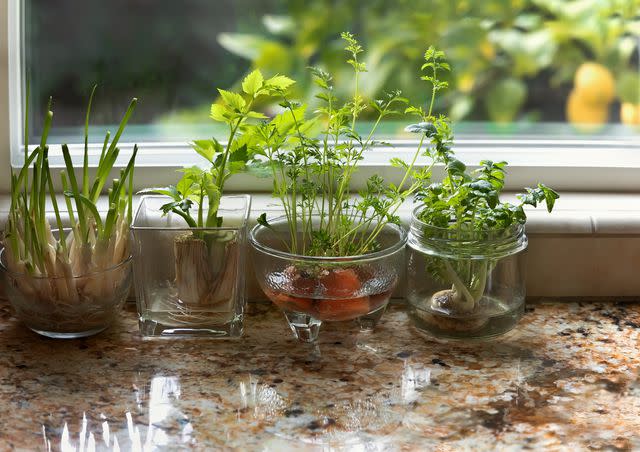
ggutarin
For a small indoor garden, forget the pots, the soil, and the mess. Plant herbs like basil, thyme, mint, and parsley in water and let them take root. They'll continue growing, you'll always have fresh garnishes on hand, and you never have to worry about pests lurking in soil.
Repurpose a Broken Mug
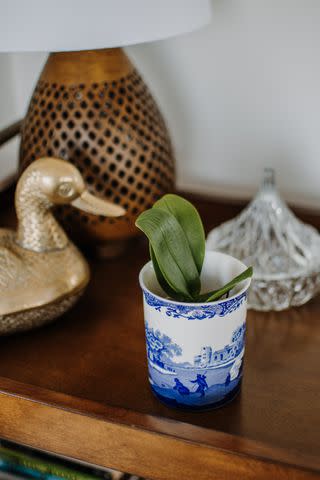
Have you ever broken the handle off one of your favorite mugs and wondered if there's any way to save it? Use it as a container for a mini version of your favorite herb, like rosemary, oregano, or thyme—just be sure it has proper drainage.
Read Next:9 Creative Vegetable Garden Ideas

